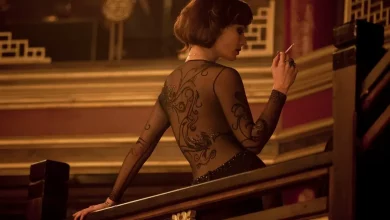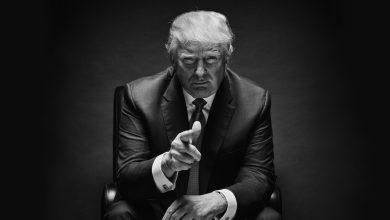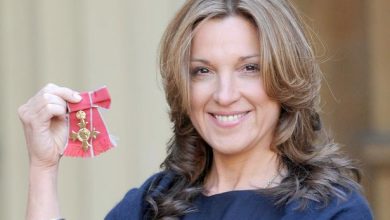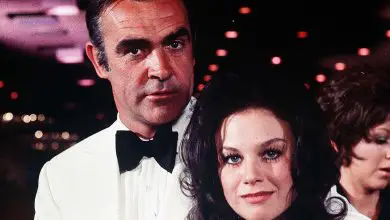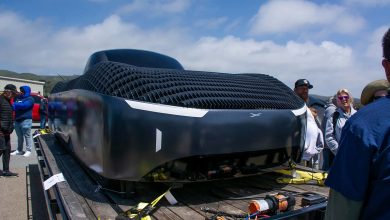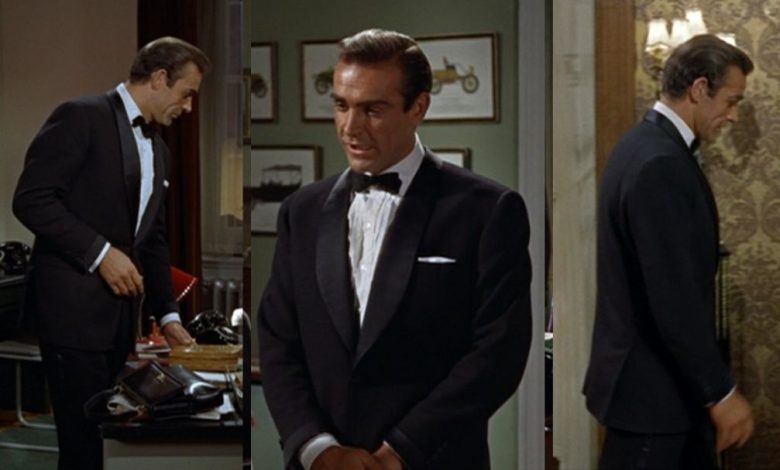
When it comes to iconic style, few fictional characters have had as lasting an influence as James Bond. Throughout the film franchise, Bond has epitomized the epitome of a well-dressed gentleman, particularly when it comes to wearing a suit. From his impeccable tailoring to his attention to detail, Bond’s suit-wearing prowess has become synonymous with elegance, sophistication, and a touch of suave.
In this article, we delve into the secrets of how to wear a suit like James Bond. We explore the various elements of Bond’s sartorial choices, including suitings, suit jackets, trousers, shirts, ties, and accessories. By understanding the nuances of Bond’s style and incorporating them into your own wardrobe, you can cultivate a refined and timeless look that exudes confidence and class.
Key Takeaways
- Suitings: Bond favors classic suitings in shades of grey, blue, and occasionally brown, with traditional cloths like worsted wool. Consider the purpose, season, and location when selecting suit colors and fabrics.
- Suit Jackets: Bond’s suit jackets feature a British silhouette, typically with two or three buttons. Pay attention to proper fit, ensuring the jacket follows the contours of your body, and choose lapel styles, vents, and pocket types that suit your personal style.
- Suit Trousers: Bond’s suit trousers come in various styles, including flat-front, darted front, and pleated options. Focus on a tailored fit, tapered or straight legs, and appropriate rise and hem length.
- Shirts: Opt for plain, solid-colored shirts in white, cream, light blue, or mid blue to achieve a timeless Bond look. Experiment with collar styles like spread collars or point collars, and consider subtle patterns such as Bengal or hairline stripes.
- Ties and Accessories: Bond’s tie collection consists of dark solids and fine patterns, often knotted with a four-in-hand knot. Enhance your suit ensemble with pocket squares, cufflinks, and belts that complement the overall look while adding a touch of individuality.
Suitings: Choose the Right Fabric for Your Suit
The foundation of any great suit lies in the choice of fabric. Bond always opts for classic suitings that exude timeless elegance without being overly flashy. Shades of grey are his go-to colors, ranging from deep charcoal to light dove grey. He also frequently wears blue suits, and occasionally incorporates brown, black, tan, and cream suits into his wardrobe. Bond prefers traditional cloths in medium to light weights, steering away from high superfine worsteds. A suit made of Super 110s worsted wool strikes the perfect balance for the modern Bond. Consider the purpose, season, and location when selecting your suitings, as they play a crucial role in determining the formality and overall look of your suit.
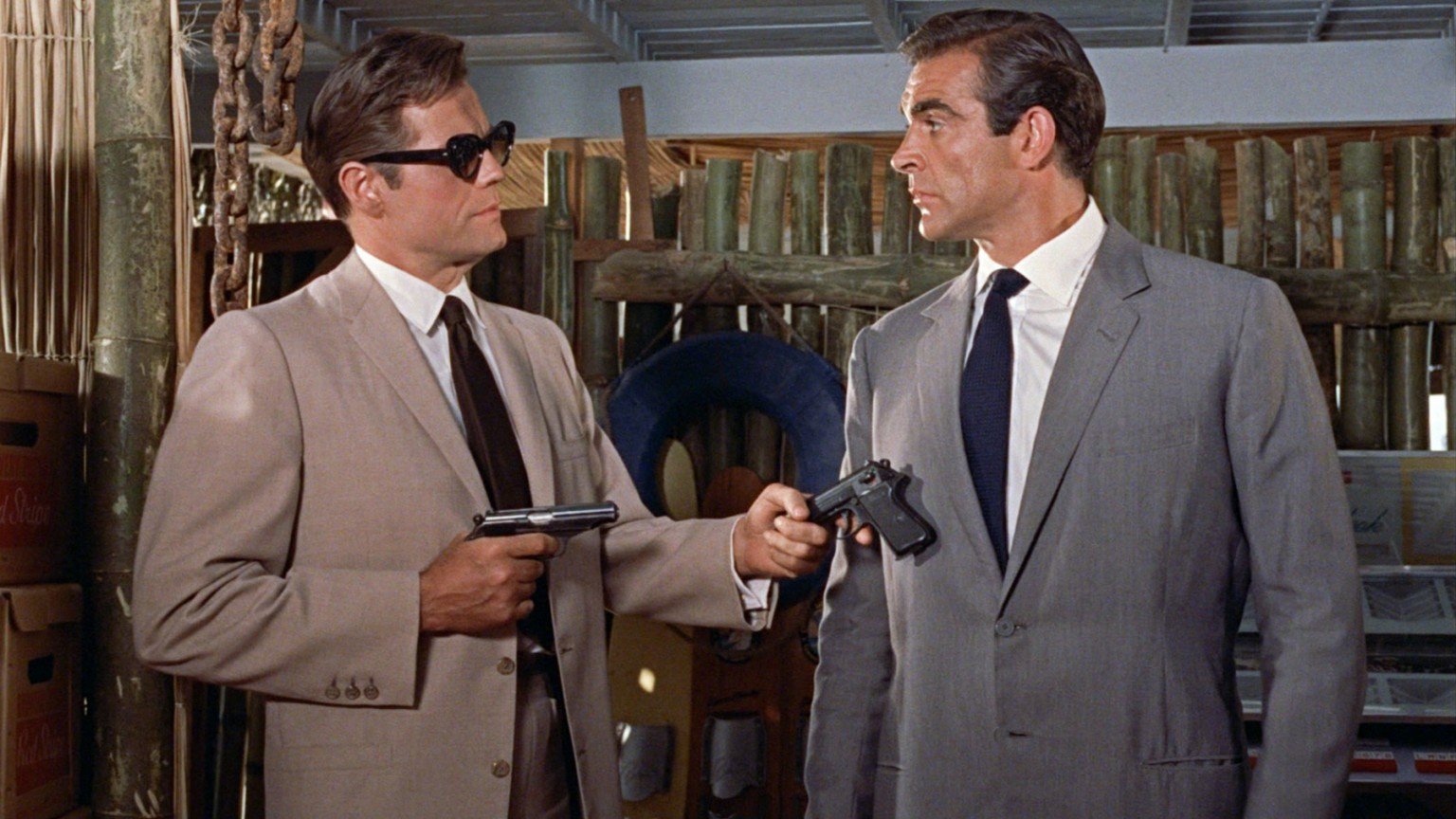
For business attire, Bond favors worsted wool suits in various cloths such as serge for year-round use, worsted flannel for cooler weather, and plain weave and gabardine for warm weather. In London, his business suits usually come in dark grey, mid grey, or dark blue, occasionally venturing into brown. When Bond travels to warm destinations, he incorporates light grey and tan suits into his business wardrobe. Patterns like plain, herringbone, glen check, pinstripe, chalk stripe, and birdseye can be found in his business suits, with windowpane, nailhead, and fine houndstooth check being less common choices.
For social occasions, Bond’s suit selection overlaps with his business suits, particularly in flannel and tan suits. However, he also wears more formal suits and leisurely options depending on the event. Mohair suits in shades of grey, blue, and brown are his choices for more formal social gatherings. For moderately formal occasions, he opts for silk dupioni suits in similar shades. In warm locations, Bond often dons mohair suits for both business and social events. During the daytime, he might switch to a tan cotton poplin or needlecord suit, or even an ecru linen suit for a more relaxed look. In the cool countryside, Bond favors simple tweed suits in brown or dark grey, occasionally featuring windowpane patterns.
Bond reserves black suits solely for mourning purposes, such as attending funerals or during periods of mourning. However, even in mourning attire, he avoids plain worsteds and instead opts for herringbone-weave worsted wool, worsted flannel, or mohair to add visual interest to an otherwise somber outfit.
Suit Jackets: Master the Classic Silhouette
When it comes to suit jackets, Bond typically favors the British silhouette, whether crafted by a London bespoke tailor or designed by renowned brands like Tom Ford. This silhouette features a full chest, a suppressed waist, straight shoulders on the natural shoulder line, and trim sleeves. Occasionally, Bond also wears Italian suits that resemble a structured British silhouette but with less emphasis on chest shape.
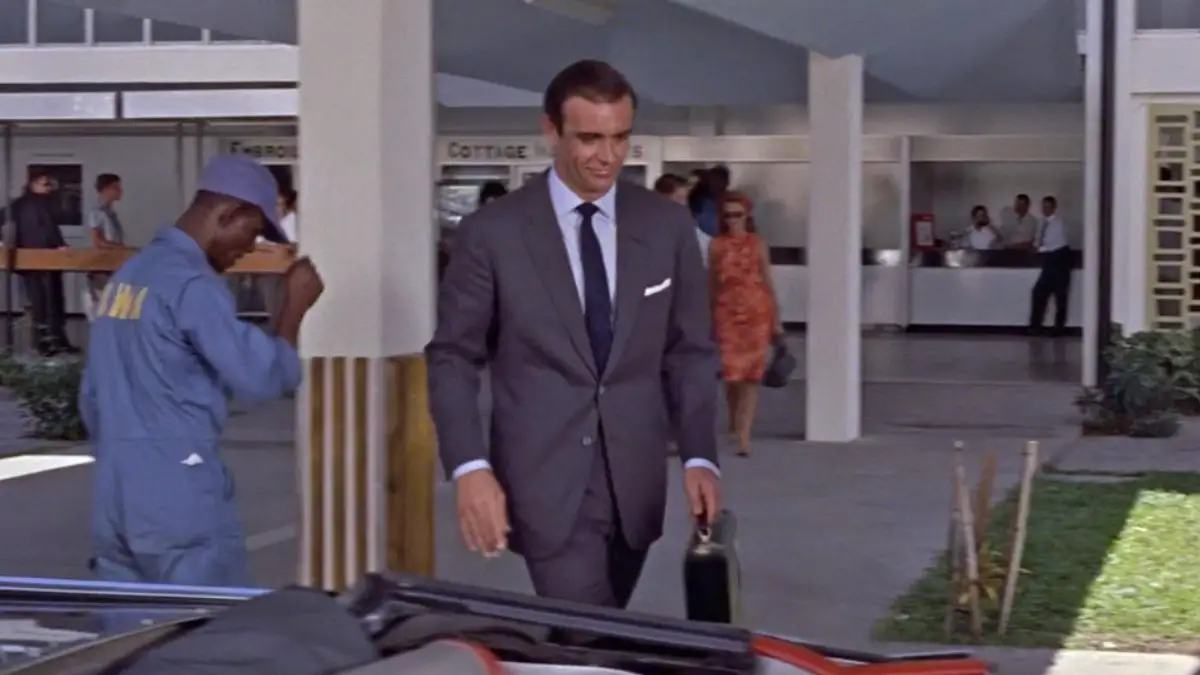
Bond’s suit jackets usually come with two or three buttons at the front, with occasional appearances of single-button jackets. When wearing a button-two jacket, Bond only fastens the top button. Fastening the bottom button is considered a fashion faux pas, as it distorts the jacket’s natural shape and gives it a sloppy appearance. In the case of three-button jackets, Bond typically leaves the top and bottom buttons unfastened, elegantly buttoning only the middle one. However, some of his jackets feature a ‘three-roll-two’ design, where the lapels roll down to the middle button, creating the illusion of a button-two jacket. Regardless, Bond never fastens the top or bottom button on three-button jackets.
Bond often keeps his suit jacket buttoned while seated, as long as the jacket’s fit allows comfortable movement. On certain occasions, he may unbutton it when seated, and both methods are acceptable. When wearing a three-piece suit, Bond adopts various styles, sometimes buttoning the jacket and other times leaving it open. Both approaches are valid and contribute to the versatility of a three-piece ensemble.
While Bond predominantly sticks to single-breasted suit jackets, he occasionally embraces the classic appeal of double-breasted suits. These can be seen in the 6×2 style or the 4×1 style, which experienced popularity, particularly in the 1980s. However, double-breasted suits are not Bond’s typical choice, as they restrict easy access to his shoulder-holstered firearm.
The styling details of Bond’s suit jackets vary, providing subtle nuances to his ensemble. He often opts for double vents, single vents, or no vents at all. Hip pockets are typically set in, featuring flaps, double-jetted configurations, or occasionally no flaps. The pockets may be straight or slanted, and occasionally include a ticket pocket. Patch pockets are a rarity in Bond’s suits, usually reserved for sportier ensembles. His cuffs typically feature three or four buttons, occasionally showcasing the distinctive five-button Tom Ford signature cuff.
Bond’s suit jacket buttons are crafted from polyester, horn, or corozo, matching or closely complementing the color of the suit itself.
Suit Trousers: Embrace the Perfect Fit
The trousers you pair with your suit are just as important as the jacket itself. Bond’s suit trousers can be categorized into different styles: flat front, darted front, double forward pleats, or double reverse pleats. Flat front trousers are the most prevalent style today, providing a sleek and modern look. Darted front trousers feature subtle darts sewn at the front, offering added fullness to the hips without pleats. British tailors often prefer trousers with darted fronts as they provide more shape.
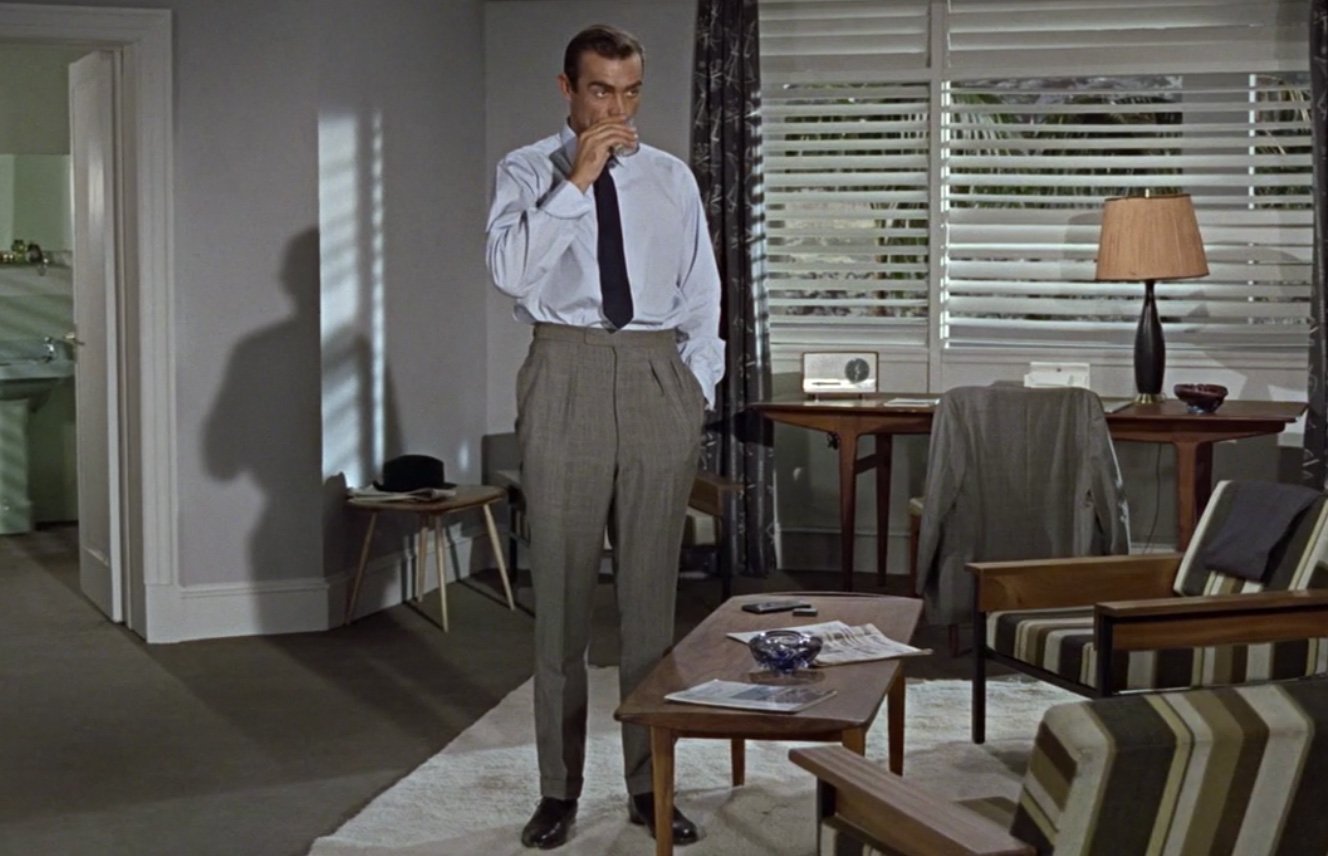
Double forward pleats represent a classic British style, with two pleats on each side that open inwards. Conversely, double reverse pleats open outwards and are more commonly associated with Italian tailoring. Double forward pleats create a trimmer appearance compared to reverse pleats.
Bond’s suit trousers exhibit tapered legs, straight legs, or flared legs of varying widths, depending on fashion trends at the time of each film. The leg finishing can include turn-ups (cuffs) or plain hems, with no direct correlation to the presence or absence of pleats.
The waistband of Bond’s suit trousers can feature side adjusters or belt loops. Side adjusters, particularly the strap and slide-buckle style, pair better with slimmer suits as they avoid creating unsightly bulges under the jacket. Bond has also been seen wearing belts with his suits on several occasions, typically matching the color of his shoes. Braces (suspenders), although not Bond’s usual style, occasionally make an appearance in his outfits.
Bond’s suit trousers often feature different buttons from the jacket, with choices ranging from flat mother-of-pearl buttons to polyester “strap” buttons originally designed for interior straps. In more recent suits, the trouser buttons match the jacket’s horn or corozo buttons, creating a cohesive look.
Suit Waistcoats: Elevate Your Style with a Three-Piece Suit
A three-piece suit is a timeless choice that exudes elegance and refinement. Bond often incorporates waistcoats into his outfits for business in London or when he wants to make a lasting impression. His waistcoats typically come with six buttons, although there are rare instances of seven-button designs or five-button waistcoats. Bond usually buttons all but the bottom button of his waistcoat. Some waistcoats have the bottom button placed on the cutaway portion, rendering it unbuttonable by choice. However, in Thunderball, Bond’s waistcoats have straight bottoms, and he fastens all of them.
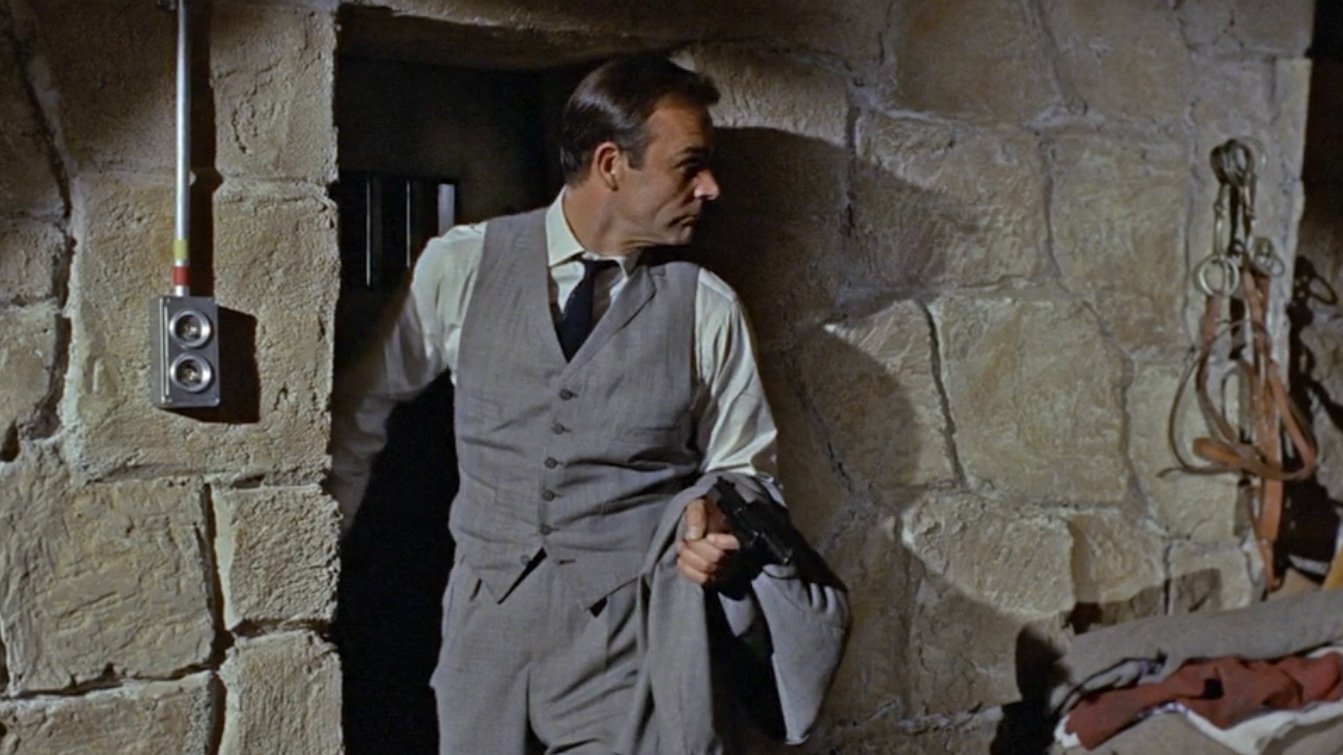
Bond occasionally sports notched lapels on his waistcoats, adding a touch of distinction without affecting their formality. The front of his waistcoats usually features four welt pockets, though some may have two welt pockets and two flap pockets, or simply two welt pockets.
The back of the waistcoat is typically lined, ensuring a neat fit under the jacket. Bond’s suit waistcoat buttons always match the jacket’s cuff buttons, contributing to a cohesive and polished appearance.
While Bond generally wears his waistcoats as part of a three-piece suit, coordinating all three pieces, there is one notable exception. In Goldfinger, he wears an odd waistcoat, a beige doeskin waistcoat, with his brown houndstooth flannel suit when visiting M’s office. This outfit deviates from the formal three-piece suit, presenting a more sporty country ensemble.
Suit Fit: Achieve the Perfect Silhouette
Bond’s suits consistently exhibit impeccable fit, tailored to perfection for a balanced and flattering look. The fit may vary over the films to reflect changing fashion trends, but the underlying principles remain constant.
A well-fitted suit jacket should appear neat and balanced, following the natural contours of your body. The length of the jacket should ideally be half the distance from the base of your neck to the floor, though it may extend slightly longer to cover your seat if necessary. The front of the jacket should be the same length as or slightly longer than the back. The shoulders can either align with your own shoulders or be extended for balance, particularly for individuals with a larger head or waist. However, extended shoulders must be adequately supported to prevent drooping.
The chest area should lie neatly without any gaping, while the waist should be closely fitted without pulling. The fastening button, whether the top of two buttons or the middle of three buttons, should align with the natural waist, which is approximately the same height as the elbow. The collar should snugly hug the back of your neck, and the back of the jacket should drape smoothly. Small folds behind the sleeve are permissible for ease of movement.
A well-cut suit jacket features high armholes, allowing the sleeves to be larger than the armhole and providing optimal freedom of movement. When properly fitted, the sleeves drape cleanly without divots at the shoulder, irrespective of the shoulder’s width. The pitch of the sleeve should follow the arm’s shape, tapering to fit closely without excess fabric. The sleeve length should end at the wrist bone, allowing 1/4 to 1/2 inch of shirt cuff to show when the arm is relaxed.
Suit trousers should fit neatly and create a clean drape. Pleated trousers should keep the pleats closed when standing. The legs can either be tapered or straight, with the rise and hem length adjusted to match current trends while maintaining harmony with the body. The rise should be long enough for the trousers to sit at the natural waist above the hip bone, promoting optimal movement and ensuring a smooth connection with the suit jacket. The hem may have a break or no break, depending on personal preference and the suit’s style.
Suit Shirts: The Perfect Foundation
A well-chosen shirt provides the foundation for a stylish suit ensemble. Bond typically wears classic dress shirts in white or light blue, occasionally introducing patterns like subtle stripes or checks. He favors shirts with a spread or semi-spread collar, which complements the proportions of his face and accommodates a variety of tie knots.
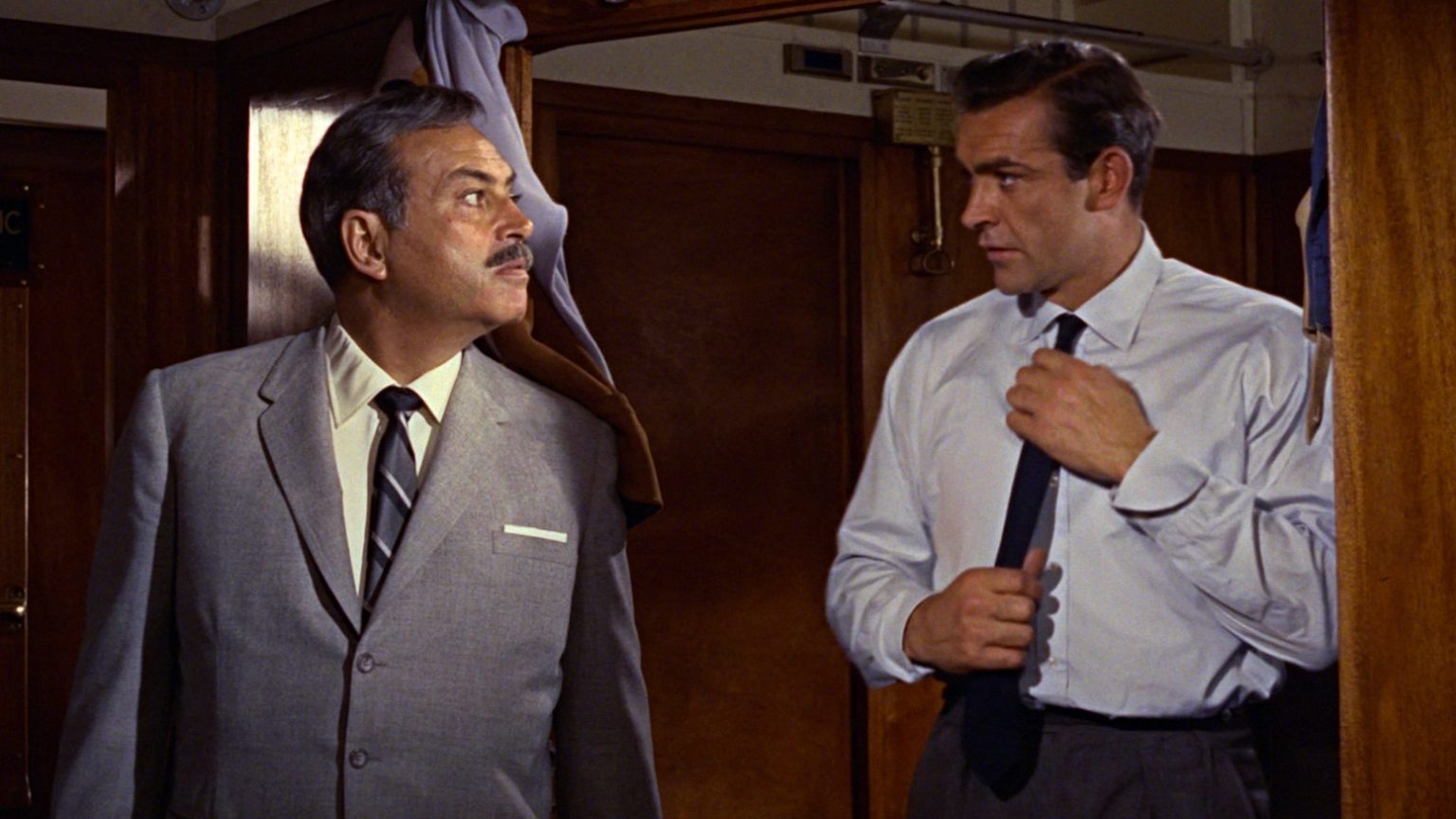
The shirt fabric is usually a high-quality cotton, such as poplin or twill, offering a smooth and refined texture. Bond often opts for shirts with double cuffs (French cuffs), which add a touch of formality and allow him to showcase an array of cufflinks. Single cuffs with button closures are less common in his wardrobe but occasionally make an appearance.
The fit of the shirt is crucial for achieving the Bond look. It should be tailored to your body shape without excessive fabric billowing or constriction. The collar should be snug but not tight, allowing room for a finger to fit comfortably between the collar and neck. The shoulders of the shirt should align with your own shoulders, and the sleeves should end at the base of your thumb when your arms are relaxed.
Bond prefers shirts with a clean, minimalistic design. Chest pockets and excessive detailing are rare in his wardrobe, as he favors a sleek and sophisticated aesthetic. However, there may be exceptions for specific film scenes or character portrayals.
Suit Ties: Master the Art of Elegance
Bond’s choice of ties reflects his impeccable taste and attention to detail. Silk ties in solid colors or subtle patterns are his go-to options, with shades of navy blue, burgundy, and black featuring prominently in his collection. Bond occasionally incorporates striped or dotted ties for added visual interest. The width of his ties varies with the prevailing fashion trends of each era.
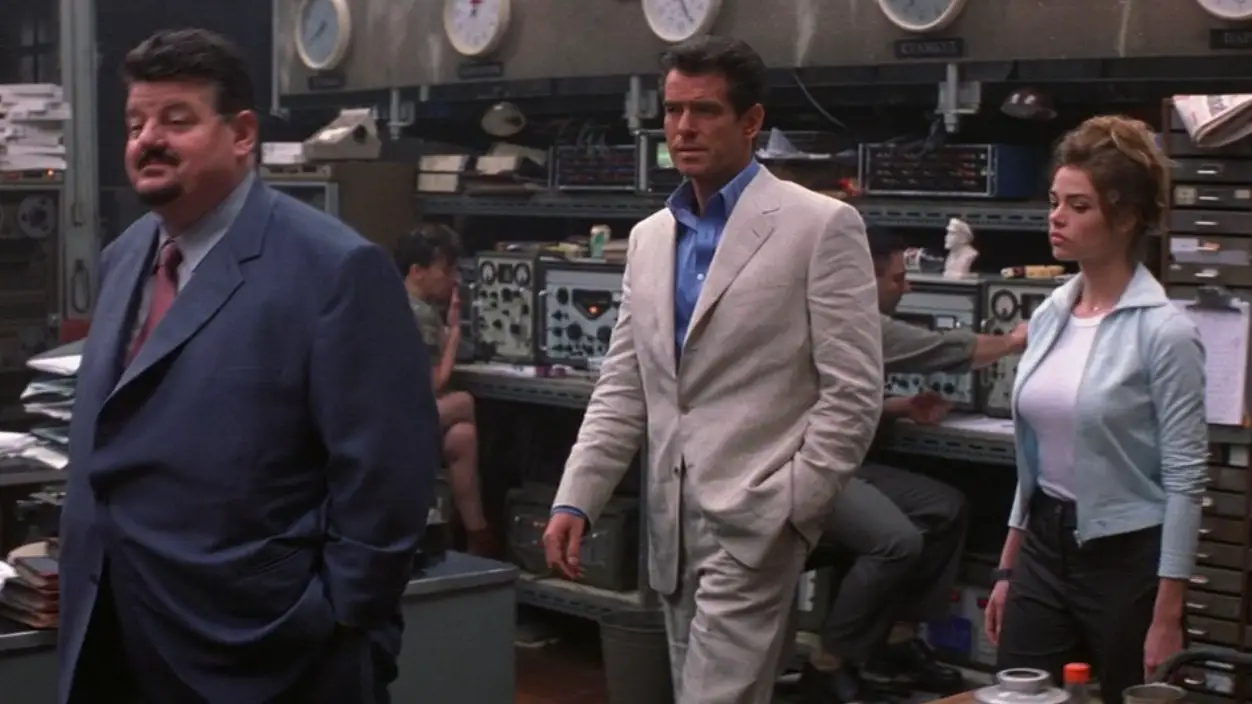
The tie knot is crucial for achieving the Bond look. Bond typically favors a Windsor knot, known for its symmetrical and substantial appearance. The knot should fill the space between the collar points, creating a balanced and harmonious look. However, Bond occasionally opts for a smaller knot, such as the four-in-hand, when a slimmer knot complements the overall aesthetic.
The tie length should be adjusted to end at the belt buckle or slightly above it, depending on personal preference and fashion trends. Excessively long or short ties should be avoided, as they disrupt the visual balance of the suit ensemble.
Suit Accessories: Refine Your Style
To complete the Bond look, attention to detail is essential. Bond often incorporates carefully selected accessories to add a touch of refinement and individuality to his ensemble. Here are some key accessories to consider:
- Cufflinks: Bond’s cufflinks are typically understated and elegant, often featuring silver or gold tones. He occasionally incorporates novelty or thematic cufflinks for specific scenes or occasions.
- Pocket Squares: Bond frequently adorns his suit pocket with a neatly folded pocket square. White linen or silk squares provide a classic and sophisticated touch, although he occasionally introduces subtle patterns or colors.
- Tie Bars: Bond occasionally wears tie bars to keep his tie in place and add a polished touch to his outfit. The tie bar should be placed between the third and fourth buttons of the shirt, securing both the tie and shirt placket.
- Belts: Bond’s choice of belts complements his shoes and coordinates with the overall color scheme of his outfit. Leather belts in shades of black, brown, or tan are his preferred options.
- Shoes: Bond’s footwear is typically black or brown, crafted from high-quality leather. Oxfords, derbies, or monk straps are his go-to styles, providing a sophisticated and timeless look. The shoes should be well-maintained and polished, completing the overall polished appearance of the suit ensemble.
- Watches: Bond is known for his appreciation of luxury timepieces. He often wears stylish and elegant watches that complement his attire, ranging from classic dress watches to sportier models.
By paying attention to these suit elements, fit, and accessories, you can emulate the refined and timeless style of James Bond. Remember that Bond’s fashion choices evolve over time, so adapting his style to contemporary trends while staying true to the classic elements will help you achieve a modern Bond look.
FAQ: Frequently Asked Questions
1. How do I choose the right suit color for different occasions?
When selecting a suit color, it’s essential to consider the occasion and the level of formality required. For business settings and formal events, traditional colors like charcoal grey, navy blue, and dark shades of brown are safe choices. These colors convey professionalism, elegance, and versatility. Lighter shades of grey, such as dove grey or light blue, can be appropriate for less formal occasions or warmer climates. Ultimately, the key is to choose a color that complements your skin tone and personal style while adhering to the dress code of the event or setting.
2. What suit fabric should I choose for different seasons?
The choice of suit fabric depends on the season and climate. For year-round use, worsted wool is an excellent option due to its durability, breathability, and versatility. It is available in various weights, allowing you to find the right balance between comfort and style. In cooler weather, consider suits made from flannel or tweed, which offer warmth and a distinctive texture. For warmer climates, lightweight fabrics like cotton or linen can provide breathability and comfort. Remember to consider the specific purpose, location, and time of day when selecting the fabric for your suit.
3. How should a suit jacket fit?
A well-fitting suit jacket should follow the natural contours of your body while allowing freedom of movement. The shoulders should align with your own and have enough support to prevent drooping. The chest should lie neatly without any gaping or pulling, and the waist should be tailored to your body shape without excessive tightness. The length of the jacket should be proportional, typically reaching half the distance from the base of your neck to the floor. The collar should hug the back of your neck, and the back of the jacket should drape smoothly. Finally, the sleeves should end at the wrist bone, allowing a quarter to half an inch of shirt cuff to show when your arms are relaxed.
4. What types of shirt collars are suitable for a suit?
A variety of shirt collar styles can complement a suit, depending on your personal preference and the overall look you wish to achieve. Classic options include spread collars and semi-spread collars, which provide a balanced and timeless appearance. Point collars offer a more traditional and understated look, while tab collars add a unique touch. Avoid button-down collars when wearing a suit, as they are generally considered less formal. Ultimately, the collar style should harmonize with the proportions of your face and tie knot, creating a polished and well-coordinated ensemble.
5. Can I wear patterned shirts with a suit?
While solid-colored shirts are the safest choice for a suit ensemble, incorporating subtle patterns can add visual interest and personality. Striped shirts, such as Bengal stripes or hairline stripes, can be a sophisticated option when paired appropriately with a suit. Ensure that the pattern is not overly bold or distracting, and consider the overall color palette and formality of the occasion. Remember to balance the patterned shirt with a solid-colored suit and complementary accessories for a refined and harmonious look.
6. What tie knot is best suited for a suit?
The choice of tie knot can enhance the overall appearance of your suit ensemble. A classic option is the four-in-hand knot, which is simple, versatile, and well-suited for most collar styles. It creates a slightly asymmetrical knot that exudes effortless elegance. If you prefer a more substantial knot, consider the Windsor or half-Windsor knot. These knots are symmetrical and slightly larger, making them suitable for spread or wide collar styles. Ultimately, choose a knot that complements your face shape and collar style while maintaining a balanced and proportional look.
7. Can I wear a suit without a tie?
Yes, it is acceptable to wear a suit without a tie, particularly in less formal or relaxed settings. However, it’s important to ensure that the suit itself is appropriately tailored and that the overall ensemble remains polished. When opting for a tieless look, consider a more casual suit fabric, such as linen or cotton, and style it with an open-collar dress shirt. Additionally, pay attention to other accessories, such as pocket squares or lapel pins, to maintain a sense of refinement and individuality.
8. What types of shoes should I wear with a suit?
When it comes to selecting shoes for a suit, classic styles in black or brown are the most versatile and timeless choices. Oxford or derby shoes with a sleek and polished appearance are excellent options for formal occasions and business settings. Monk strap shoes offer a sophisticated alternative, while loafers can be appropriate for more relaxed or casual environments. It’s essential to choose shoes made from high-quality leather, keep them well-maintained and polished, and ensure they match the color of your belt for a cohesive and refined look.
9. How should a suit trouser fit?
A well-fitted suit trouser should have a clean and tailored appearance. The waistband should sit comfortably at your natural waist above the hip bone, allowing the trousers to move with your body and maintaining visual harmony with the suit jacket. The legs should be tapered or straight, depending on current fashion trends and personal preference. Pleated trousers should have pleats that stay closed when standing, and flat-front trousers should lie smoothly across the hips. The length of the trousers should be adjusted to cover the ankles without bunching on top of the shoe or dragging on the floor, maintaining a clean and elegant drape.
10. What accessories can I add to enhance my suit ensemble?
Accessories play a crucial role in adding refinement and individuality to your suit ensemble. Consider incorporating cufflinks, pocket squares, tie bars, and belts to elevate your look. Cufflinks should be understated and elegant, matching the overall aesthetic of your suit. Pocket squares offer an opportunity to introduce a touch of color or pattern while maintaining a sophisticated appearance. Tie bars serve both a functional and decorative purpose, keeping your tie in place while adding a polished detail. Belts should coordinate with your shoe color and complete the overall color scheme of your outfit. Remember, the key is to choose accessories that complement your suit without overpowering it, striking a balance between style and subtlety.
Conclusion
Channeling James Bond’s suit-wearing expertise allows you to embrace a style that is simultaneously classic and contemporary. By paying attention to suit color, fabric, fit, and the interplay of various elements such as shirts, ties, and accessories, you can cultivate a refined and sophisticated appearance that commands attention and exudes confidence. Remember, the key lies not just in emulating Bond’s wardrobe choices but in adapting them to your own personal style and preferences. So, step into the world of James Bond and elevate your suit game to new heights of suavity and sophistication.


